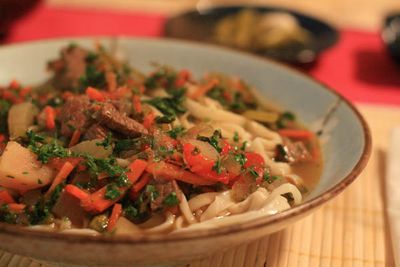Ukrainian Borscht Poltava Style : My Family Borshch Recipe
You can spell it borscht, borshch, or borsch, but by any name, it’s the dish that embodies the essence of Ukrainian food culture–colorful, rich and vibrant. To call it soup wouldn’t be correct, because Ukrainian borscht is a dish more like minestrone, pot-au-feu or cocido in its heartiness. Every region of Ukraine has different varieties of borscht. There is no one authentic recipe, although there are classical versions. Borscht in Lviv in the west of Ukraine is ruby-red and includes small mushroom-filled dumplings; it’s an essential Christmas Eve dish. In the south of Ukraine, borscht is made with fish. The Central Ukrainian-style borscht–the most popular variation–is famous for its sweet-sour flavors. Borscht can be made with beef, pork, chicken, duck, beans, and even fish. It can be vegetarian. It can be soured with tomatoes, beet kvas, vinegar, sour cherries, rhubarb or red currants. It can be flavored with mushrooms or dried plums. It can include white beets and be pale in color. It can be spicy with paprika or suave with sour cream.

Outside of Eastern Europe, borscht tends to be associated with Russian cooking, since people tend to label everything from the former Soviet Union as Russian. Borscht in different variations is also enjoyed in Poland (barszcz), Lithuania (barščiai) and Romania (borş). Nevertheless, if you think of borscht as soup with beets, cabbage and tinted red with tomatoes, then it’s the Ukrainian version that you have in mind. According to the Russian food historian, Olga Syutkina, that version became popular in Russia at the end of the 18th century, when this dish was introduced on the tsarist army’s menu. Originally, borscht was the food of the peasants, because it was easy to cook in advance and was nutritious enough to be served as a one-dish meal. With the immigration of the Ashkenazi Jewish community to North America, borscht–the English spelling gives away its Yiddish roots–became popular in the New World.
















Joi in Giorgio Armani Mania : Long Lost Favorite Perfume: Yes!! January 25, 2024 at 2:54am